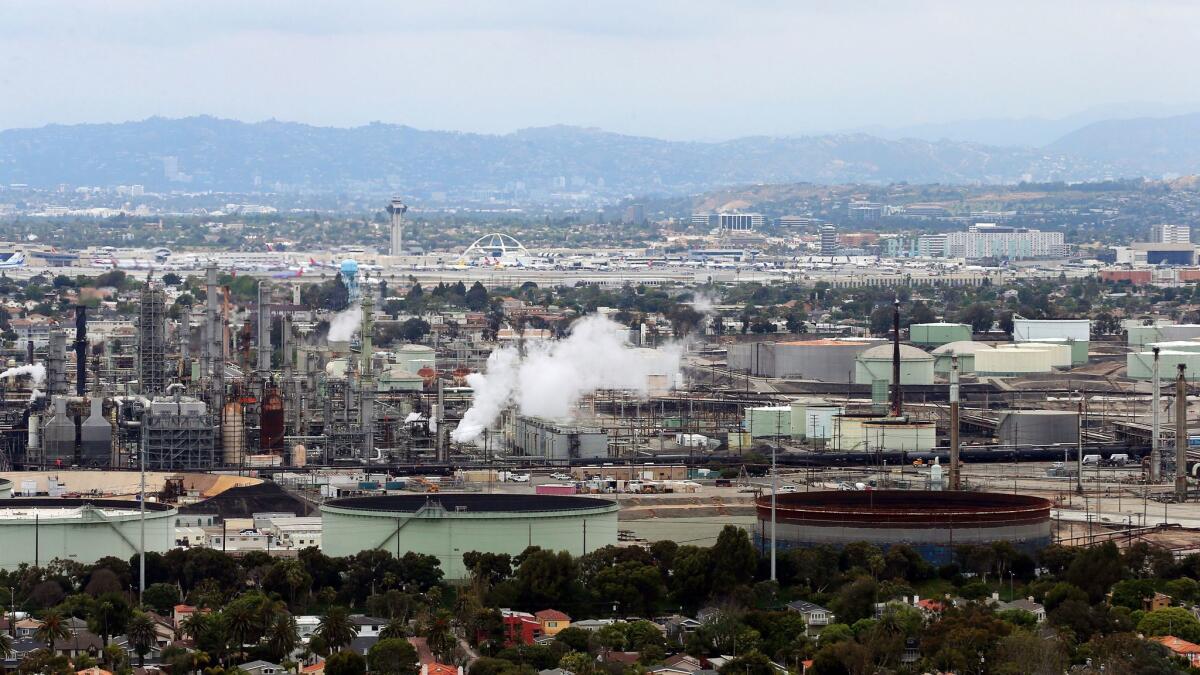Op-Ed: California is handling climate change all wrong

- Share via
Gov. Jerry Brown has won praise for promising that California will live up to the Paris accord despite President Trump’s withdrawal from the treaty. He also signed a climate deal with China last month, and has unveiled plans for a global climate summit in San Francisco next year. Earlier this week, California lawmakers voted to extend the state’s cap-and-trade program for another 10 years.
The message is clear: With a few other states, California is going it alone — an approach that is popular locally and resonates with much of the world.
But, while Brown should be commended for showing leadership where Trump has not, the truth is that California’s plans for fulfilling the Paris accord and its carbon-cutting commitments will be expensive for the state while achieving slightly more than nothing for the planet.
At the moment, California’s greenhouse gas emissions account for less than 1% of global emissions, and a little less than 7% of U.S. emissions. The state now plans to cut its emissions by the equivalent of 181.5 million tons of carbon dioxide by 2030 — to 40% below its 1990 levels.
If, instead, California were to develop green technologies so cheap they could actually outcompete fossil fuels, the whole world would switch to them.
Although this is a much bigger cut than California achieved with its 2006 climate change legislation, it’s still nowhere near enough to have a meaningful effect on global warming overall. Even if California succeeds in making the new cuts and sticks to them for the rest of the century, according to calculations using a standard model of the U.N. Climate Panel, they will amount to a difference of .008 degrees Fahrenheit (.0044 degrees Celsius) — a minuscule drop in the bucket of the cuts needed in order to limit total global warming to no more than 2 degrees Celsius, the number climate activists have identified as a dangerous tipping point.
And there’s a big caveat to this small achievement. When limitations are placed on major emitters in one geographical location, the emitters often move to locations with lighter regulatory regimes, bringing their emissions along with them, in a process known as “carbon leakage.” One study published in the Review of Economics and Statistics found that around 40% of the carbon savings that resulted from the Kyoto Protocol was lost to leakage. Much of the emissions that are cut in California could turn up elsewhere. Indeed, one simulation suggests that practically all of California’s cuts would be lost to carbon leakage.
What’s more, California’s official estimates put the cost of its climate change policy at $13 billion to $22.5 billion a year — and such estimates often prove to be optimistic. The European Union, one of few entities that has attempted cuts of this magnitude, underestimated the cost of its emissions reduction policy by as much as 100%. (Mexico is likely to have underestimated its climate policy costs by even more.) If California can expect to lose a similar percentage of its GDP, the annual cost would come to about $50 billion. With the state’s promises to reduce emissions by 80% before 2050, these costs would go up even more — and have little to no effect on the environment.
Most Californians will feel these costs in the form of higher gasoline and electricity prices. But the real reason carbon cuts are so expensive is they require the economy to shift from low-cost fossil fuels to more pricey, often less efficient green energy. People like to claim that green energy is already competitive. This is far from true. For instance, when solar energy is produced, it is all produced at the same time — when the sun shines. The energy thus floods the market and becomes less valuable. Models show that when solar makes up 15% of the market, the value of its electricity is halved. In California, when solar reaches 30% of the market, its value drops by more than two-thirds.
The more we rely on unpredictable renewables, the more we need fossil fuel as a backup for when the sun is not shining or the wind is not blowing. When fossil fuel is not relied upon but then required in large amounts, the price goes up, and energy costs overall spike when energy is most needed. For this reason, subsidies will be required for a long time. The International Energy Agency estimates that, this year alone, $125 billion will be spent on solar and wind subsidies globally.
A smarter approach to climate policy — and one befitting California’s role as one of the most innovative states in the country — would be to focus on making green energy cheaper. In other words, spend more on R&D for green energy. Although some argue that agreements like the Paris accord prompt investment in research, most of the investment is absorbed by existing inefficient technologies, leaving little for actual innovation. Germany’s much-celebrated climate change policy, which was designed to move that country toward renewable energy and away from nuclear energy and fossil fuel, had a “very low” effect on innovation, according to a panel of energy experts in a report to the German parliament.
California is embracing huge costs while doing virtually nothing for the environment. While the approach might look good, it doesn’t help much. If, instead, California were to develop green technologies so cheap they could actually outcompete fossil fuels, the whole world would switch to them.
Bjorn Lomborg is director of the Copenhagen Consensus Center and the author of “The Skeptical Environmentalist.”
Follow the Opinion section on Twitter @latimesopinion or Facebook
More to Read
A cure for the common opinion
Get thought-provoking perspectives with our weekly newsletter.
You may occasionally receive promotional content from the Los Angeles Times.










